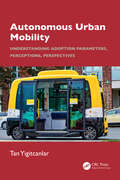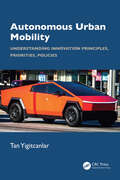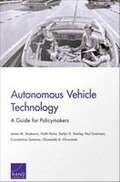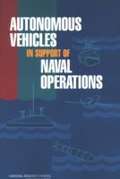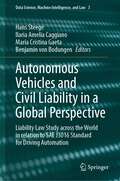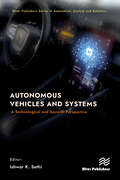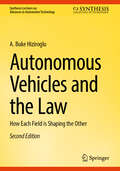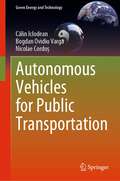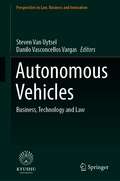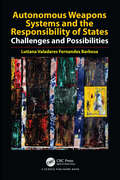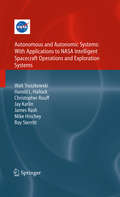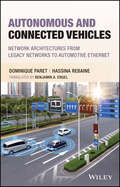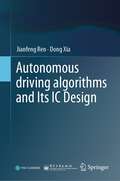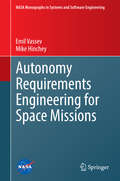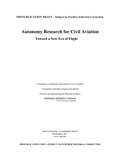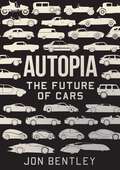- Table View
- List View
Autonomous Urban Mobility: Understanding Adoption Parameters, Perceptions, Perspectives
by Tan YigitcanlarThis book delves into the complex landscape of autonomous urban mobility, analysing the factors that influence public adoption, stakeholder perspectives, and societal perceptions in this rapidly evolving field. Aimed at scholars, policymakers, urban planners, and industry professionals, this book offers a thorough exploration of the key elements driving the integration of autonomous vehicles in urban settings. Drawing on empirical evidence from diverse case studies, it first investigates public awareness, emphasising the roles of knowledge, exposure, and media in shaping perceptions of autonomous vehicles, and underscores the critical need for targeted awareness campaigns. Subsequent chapters examine pre-trial attitudes towards autonomous shuttles, demonstrating how initial experiences significantly impact adoption willingness, and advocate for pilot programs to cultivate informed, positive perceptions.This book also explores the potential of smart mobility solutions to bridge first/last mile gaps, presenting data on how autonomous vehicles can improve urban transport efficiency and accessibility. By analysing socio-demographic predictors, it highlights varying perceptions of the benefits and challenges of autonomous demand-responsive transit, underscoring the importance of tailored strategies for diverse urban populations. Stakeholder perspectives, gathered through interviews and case studies, offer practical recommendations for overcoming technological, regulatory, and societal hurdles. Comparative insights from international case studies broaden the understanding of local factors influencing autonomous vehicle acceptance, while advanced modelling techniques identify the key drivers of driverless car adoption. Finally, this book explores the transformative potential of autonomous vehicles in developing countries, offering visionary insights into their capacity to reshape urban landscapes.With its data-rich content and forward-thinking analysis, this book is an indispensable guide to the future of urban transportation and the critical role of autonomous mobility.This volume, alongside its companion—Autonomous Urban Mobility: Understanding Innovation Principles, Priorities, Policies—offers a holistic view of autonomous urban mobility. Together, these books provide a comprehensive exploration of the rapidly evolving landscape of autonomous urban mobility, the principles guiding its innovation, the wide-ranging impacts of its adoption on society, policy, and urban environments, and the transformative potential of autonomous vehicles in the future of urban transportation.
Autonomous Urban Mobility: Understanding Innovation Principles, Priorities, Policies
by Tan YigitcanlarThis book provides a comprehensive exploration of the rapidly evolving field of autonomous urban mobility, examining its transformative potential and the principles guiding its innovation. This essential resource offers deep insights into the societal, policy, and urban impacts of autonomous vehicles, drawing on an extensive body of research. Beginning with a review of smart urban mobility innovations, the book explores technological advancements such as connected vehicles, mobility-as-a-service platforms, and shared autonomous systems, evaluating their successes and challenges.This book traces the evolution of autonomous vehicle research over the past two decades, identifying key trends, methodologies, and future research directions, underscoring the importance of interdisciplinary approaches to address complex challenges. Subsequent chapters critically assess the technical capabilities, societal impacts, and policy frameworks necessary for the widespread adoption of autonomous vehicles, with a focus on implications for land use, infrastructure, and environmental planning. Public acceptance is a recurring theme, with an in-depth analysis of socio-demographic, psychological, and contextual factors influencing attitudes towards autonomous mobility. This book also examines the role of shared autonomous systems in addressing urban challenges such as congestion and equity, highlighting their potential to create more sustainable urban transportation networks. Concluding with a discussion on the disruptive impacts of autonomous vehicles on urban form and land use, the author provides a balanced perspective on the opportunities and risks of mobility-as-a-service.This key reference book equips academics, policymakers, urban planners, and industry professionals with the knowledge to navigate the complex interplay of technology, policy, and societal impact, advancing the vision of smarter and more sustainable cities.This volume, alongside its companion—Autonomous Urban Mobility: Understanding Adoption Parameters, Perceptions, Perspectives—offers a holistic view of autonomous urban mobility. Together, these books provide a comprehensive exploration of the rapidly evolving landscape of autonomous urban mobility, the principles guiding its innovation, the wide-ranging impacts of its adoption on society, policy, and urban environments, and the transformative potential of autonomous vehicles in the future of urban transportation.
Autonomous Vehicle Navigation: From Behavioral to Hybrid Multi-Controller Architectures
by Lounis AdouaneImprove the Safety, Flexibility, and Reliability of Autonomous Navigation in Complex EnvironmentsAutonomous Vehicle Navigation: From Behavioral to Hybrid Multi-Controller Architectures explores the use of multi-controller architectures in fully autonomous robot navigation-even in highly dynamic and cluttered environments. Accessible to researchers
Autonomous Vehicle Technology: A Guide for Policymakers
by James M. Anderson Constantine Samaras Paul Sorensen Karlyn D. Stanley Oluwatobi A. Oluwatola Kalra NidhiThe automotive industry appears close to substantial change engendered by "self-driving" technologies. This technology offers the possibility of significant benefits to social welfare--saving lives; reducing crashes, congestion, fuel consumption, and pollution; increasing mobility for the disabled; and ultimately improving land use. This report is intended as a guide for state and federal policymakers on the many issues that this technology raises.
Autonomous Vehicle Technology: Global Exploration and Chinese Practice (Unmanned System Technologies)
by Mingfang DuThe subject of this book is artificial intelligence (AI), introducing the fast road sensing algorithm and system based on image pattern recognition for unmanned vehicle, especially for traffic sign recognition and complex road recognition. With rich figures and credible data, this book systematically and comprehensively describes the core technology and industrialization focus of today's unmanned vehicle system, which can be used as a reference for R & D Engineers and industrialization practitioners of unmanned vehicle, and it can also be used as a teaching material for higher grades and postgraduates in colleges and universities.
Autonomous Vehicles In Support Of Naval Operations
by National Research Council of the National AcademiesThe National Academies Press (NAP)--publisher for the National Academies--publishes more than 200 books a year offering the most authoritative views, definitive information, and groundbreaking recommendations on a wide range of topics in science, engineering, and health. Our books are unique in that they are authored by the nation's leading experts in every scientific field.
Autonomous Vehicles and Civil Liability in a Global Perspective: Liability Law Study across the World in relation to SAE J3016 Standard for Driving Automation (Data Science, Machine Intelligence, and Law #3)
by Hans Steege Ilaria Amelia Caggiano Maria Cristina Gaeta Benjamin Von BodungenIn the automotive sector, digitalisation, connectivity and automation are rapidly expanding. In tomorrow’s vehicles, human beings will merely be passengers – which raises a host of complex legal issues regarding accidents involving self-driving vehicles. This book is the first to offer a comprehensive, global overview of civil liability regimes for all levels of vehicle automation in jurisdictions that represent some of the most important markets for the automotive industry. After a technical introduction to how self-driving cars work, the individual chapters analyse the liability for driving automation at SAE J3016 levels 0 through 5 from a country-specific perspective. All chapters were written by experts in the field and follow a uniform legal structure. Hence, the book offers an essential comparative analysis of similarities and differences in the jurisdictions examined, while also providing suggestions for future legislative changes at the national and international level. The book is not only relevant for legal scholars and practitioners but will also be of particular interest to anyone involved in the design, manufacture, distribution and operation of self-driving vehicles.
Autonomous Vehicles and Systems: A Technological and Societal Perspective (River Publishers Series in Automation, Control and Robotics)
by Ishwar K. SethiThis book captures multidisciplinary research encompassing various facets of autonomous vehicle systems (AVS) research and developments. The AVS field is rapidly moving towards realization with numerous advances continually reported. The contributions to this field come from widely varying branches of knowledge, making it a truly multidisciplinary area of research and development. The topics covered in the book include: AI and deep learning for AVS Autonomous steering through deep neural networks Adversarial attacks and defenses on autonomous vehicles Gesture recognition for vehicle control Multi-sensor fusion in autonomous vehicles Teleoperation technologies for AVS Simulation and game theoretic decision making for AVS Path following control system design for AVS Hybrid cloud and edge solutions for AVS Ethics of AVS
Autonomous Vehicles and Virtual Reality: The New Automobile Industrial Revolution
by Andras KemenyThis book concisely describes the technologies, human perception, and cognition issues relevant to autonomous vehicles. It also gives an insight in the changes bring about our future everyday lives.Autonomous vehicles are the future of the automobile industry. Automated driving (AD), also called self-driving, raises however several multiple questions, among them those of user safety and acceptation. Comprehensive HMI system design, with windshield display technics, will be necessary to deal with driving task delegations, bringing the use of VR or augmented reality (AR) technologies. In addition, the use of VR for all the vehicle interiors will progressively be proposed for entertainment, online business activities and for modified visual motion perception to alleviate car sickness, a form of motion sickness. Indeed, car sickness is already well known for many passengers, especially when reading or operating smartphones or other display devices. It is called to increase significantly with the introduction of autonomous vehicles where all users will be for long periods in various sitting positions. These two new trends, AD and VR, are already modifying our relationship with the world and the society. All together, they will change our way of life forever. The book will be of interest to professionals in the auto industry, researchers in automotive engineering and computer science and all those interested in the future of transport.
Autonomous Vehicles and the Law: How Each Field is Shaping the Other (Synthesis Lectures on Advances in Automotive Technology)
by A. Buke HizirogluDisciplines can no longer be isolated. Technology has rapidly evolved to the point that driverless vehicles have truly become a reality and are not something out of a futuristic exhibition from the 1950s. However, engineers and researchers working on the development of autonomous vehicles cannot ignore the policy implications and policymakers as well as attorneys cannot ignore the technology. We are at a point where cross-disciplinary collaboration is vital in order to produce a technology that will immensely benefit society. This is the goal of this book: to educate autonomous vehicle developers on legal theory at the most basic level. Both policymakers and lawyers may also find the book helpful in gaining a basic understanding of the technology the developers are working on. The 2nd edition will dive further into cyber security as well as provide legal hypotheticals to give a perspective to engineers or others working in the field. Additionally, it will focus more on liability,which has had some changes recently.
Autonomous Vehicles for Public Transportation (Green Energy and Technology)
by Bogdan Ovidiu Varga Călin Iclodean Nicolae CordoșThis book presents an interdisciplinary approach to autonomous driving technology design and development. It discusses a methodology of simulation that allows specialists to evaluate autonomous vehicle sensors functionality and integration, energy flow, efficiency, range, and service under public transport.The design, calibration, and physical model behind each autonomous vehicle sensor and component is explained. For each specific vehicle, the powertrain is analyzed, and output results are presented through the use of specific automotive industrial software (IPG CarMaker).The book gives the reader a clear perspective of the key factors influencing the global functionality of autonomous shuttle buses with respect to both their inner components the variable exterior factors and an exhaustive legal perspective in relation of their presence on public roads.
Autonomous Vehicles: Business, Technology and Law (Perspectives in Law, Business and Innovation)
by Steven Van Uytsel Danilo Vasconcellos VargasThis edited book aims to address challenges facing the deployment of autonomous vehicles. Autonomous vehicles were predicted to hit the road by 2017. Even though a high degree of automation may have been achieved, vehicles that can drive autonomously under all circumstances are not yet commercially available, and the predictions have been adjusted. Now, experts even say that we are still decades away from fully autonomous vehicles. In this volume, the authors form a multidisciplinary team of experts to discuss some of the reasons behind this delay. The focus is on three areas: business, technology, and law. The authors discuss how the traditional car manufacturers have to devote numerous resources to the development of a new business model, in which the sole manufacturing of vehicles may no longer be sufficient. In addition, the book seeks to introduce how technological challenges are creating a shift toward connected autonomous vehicles. Further, it provides insight into how regulators are responding to the insufficiently tested technology and how lawyers try to answer the liability question for accidents with these autonomous vehicles.
Autonomous Weapons Systems
by Liu Claus Kreß Susanne Beck Robin Geiß Nehal Bhuta Hin-YanThe intense and polemical debate over the legality and morality of weapons systems to which human cognitive functions are delegated (up to and including the capacity to select targets and release weapons without further human intervention) addresses a phenomena which does not yet exist but which is widely claimed to be emergent. This groundbreaking collection combines contributions from roboticists, legal scholars, philosophers and sociologists of science in order to recast the debate in a manner that clarifies key areas and articulates questions for future research. The contributors develop insights with direct policy relevance, including who bears responsibility for autonomous weapons systems, whether they would violate fundamental ethical and legal norms, and how to regulate their development. It is essential reading for those concerned about this emerging phenomenon and its consequences for the future of humanity.
Autonomous Weapons Systems and the Responsibility of States: Challenges and Possibilities
by Lutiana Valadares Fernandes BarbosaThis book reviews whether the existing framework in place can effectively address breaches in the context of Autonomous Weapons Systems (AWS). The work endeavors to map out the main gaps and some possible approaches to address them. Part I sets the ground. First, it provides a concept of AWS. Next, it discusses the accountability gap AWS generate and shows how the international community has put far more emphasis on individual responsibility rather than state responsibility. Part II analyzes the challenges AWS pose to the regime governing state responsibility under international law, as codified in the Draft Articles on State Responsibility (ARSIWA). In this regard, it discusses attribution, breach of an international obligation, tempus comissi delicti, multiple states involved in a breach, force majeure, assurance of non-repetition, issues related to damage, the human-machine interaction and its impacts on state´s responsibility, responsibility for not using AWS, weapons review and the duty of due diligence. Part III summarizes the challenges discussed in part II in thirteen issues of concern and presents possible paths de lege ferenda to address each of those issues, mainly a paradigm shift in attribution and strict liability, among seven other more specific proposals. The conclusion reached is that the current regime on the international responsibility of states is insufficient to deal with the new challenges AWS pose. De lege ferenda, the book argues for following the paths suggested in part III. It also reflects on parts II and III's findings and how many of AWS's challenges to state´s responsibility apply to other autonomous devices. Therefore, through the case study of AWS, this work also opens the broader discussion of the gaps in the international responsibility of states regarding autonomous device misdoings.
Autonomous and Autonomic Systems: With Applications To Nasa Intelligent Spacecraft Operations And Exploration Systems (NASA Monographs in Systems and Software Engineering)
by Christopher Rouff Michael Hinchey Walt Truszkowski James Rash Jay Karlin Roy Sterritt Harold HallockThis book provides an in-depth discussion of autonomous and autonomic systems, their interdependencies, differences and similarities. Current and pending issues in these evermore increasingly important subjects are highlighted and discussed. Concepts, ideas and experiences are explored in relation to real-life NASA systems in spacecraft control and in the exploration domain.
Autonomous and Connected Vehicles: Network Architectures from Legacy Networks to Automotive Ethernet
by Dominique Paret Hassina RebaineAUTONOMOUS AND CONNECTED VEHICLES Discover the latest developments in autonomous vehicles and what the future holds for this exciting technology In Autonomous and Connected Vehicles, networking experts Dominique Paret and Hassina Rebaine deliver a robust exploration of the major technological changes taking place in the field, and describe the different levels of autonomy possible with current technologies and the legal and regulatory contexts in which new autonomous vehicles will circulate. The book also includes discussions of the sensors, including infrared, ultrasound, cameras, lidar, and radar, used by modern autonomous vehicles. Readers will enjoy the intuitive descriptions of Advanced Driver Assistance Systems (ADAS), network architectures (CAN-FD, FlexRay, and Backbone Ethernet), and software that power current and future autonomous vehicles. The authors also discuss how ADAS can be fused with data flowing over newer and faster network architectures and artificial intelligence to create greater levels of autonomy. The book also includes: A thorough introduction to the buzz and hype surrounding autonomous and connected vehicles, including a brief history of the autonomous vehicle Comprehensive explorations of common issues affecting autonomous and connected vehicles, including regulatory guidelines, legislation, relevant norms and standards, and insurance issues Practical discussions of autonomous vehicle sensors, from DAS to ADAS and HADAS, and VA L3 to L5 In-depth examinations of networks and architecture, including discussions of data fusion, artificial intelligence, and hardware architecture in vehicles Perfect for graduate and undergraduate students in programs dealing with the intersection of wireless communication technologies and vehicles, Autonomous and Connected Vehicles is also a must-read reference for industry professionals and researchers seeking a one-stop reference for the latest developments in vehicle communications technology.
Autonomous and Integrated Parking and Transportation Services
by Amalendu ChatterjeeIn this book, the author outlines a Robust Web Parking, Truck and Transportation Portal (RWPTTP) for integrating parking and transportation services – a revolutionary approach in contrast to incremental change for managing traffic congestion. Autonomous vehicle technology, artificial intelligence, internet of things (IOT), and other interconnected hardware and software tools will assist autonomous parking and transportation services and provide next-century infrastructure for consolidated transportation customer services. The book highlights currently available autonomous parking and transportation technologies, and the development of an integrated and intelligent transportation service/system (IITS) platform, with specific use of technologies to reconfigure the transportation industry. The author also suggests many regulatory and policy changes to simplify data collection, traffic operation, introduction of a duplicate transportation system using light rail (LRs) and high speed rail (SPRs), and redistribution of parking spaces along such routes, using renewable energy.
Autonomous driving algorithms and Its IC Design
by Jianfeng Ren Dong XiaWith the rapid development of artificial intelligence and the emergence of various new sensors, autonomous driving has grown in popularity in recent years. The implementation of autonomous driving requires new sources of sensory data, such as cameras, radars, and lidars, and the algorithm processing requires a high degree of parallel computing. In this regard, traditional CPUs have insufficient computing power, while DSPs are good at image processing but lack sufficient performance for deep learning. Although GPUs are good at training, they are too “power-hungry,” which can affect vehicle performance. Therefore, this book looks to the future, arguing that custom ASICs are bound to become mainstream. With the goal of ICs design for autonomous driving, this book discusses the theory and engineering practice of designing future-oriented autonomous driving SoC chips.The content is divided into thirteen chapters, the first chapter mainly introduces readers to the current challenges and research directions in autonomous driving. Chapters 2–6 focus on algorithm design for perception and planning control. Chapters 7–10 address the optimization of deep learning models and the design of deep learning chips, while Chapters 11-12 cover automatic driving software architecture design. Chapter 13 discusses the 5G application on autonomous drving. This book is suitable for all undergraduates, graduate students, and engineering technicians who are interested in autonomous driving.
Autonomy Requirements Engineering for Space Missions (NASA Monographs in Systems and Software Engineering)
by Mike Hinchey Emil VassevAdvanced space exploration is performed by unmanned missions with integrated autonomy in both flight and ground systems. Risk and feasibility are major factors supporting the use of unmanned craft and the use of automation and robotic technologies where possible. Autonomy in space helps to increase the amount of science data returned from missions, perform new science, and reduce mission costs. Elicitation and expression of autonomy requirements is one of the most significant challenges the autonomous spacecraft engineers need to overcome today. This book discusses the Autonomy Requirements Engineering (ARE) approach, intended to help software engineers properly elicit, express, verify, and validate autonomy requirements. Moreover, a comprehensive state-of-the-art of software engineering for aerospace is presented to outline the problems handled by ARE along with a proof-of-concept case study on the ESA's BepiColombo Mission demonstrating the ARE's ability to handle autonomy requirements.
Autonomy Research for Civil Aviation: Toward a New Era of Flight
by Committee on Autonomy Research for Civil AviationThe development and application of increasingly autonomous (IA) systems for civil aviation is proceeding at an accelerating pace, driven by the expectation that such systems will return significant benefits in terms of safety, reliability, efficiency, affordability, and/or previously unattainable mission capabilities. IA systems range from current automatic systems such as autopilots and remotely piloted unmanned aircraft to more highly sophisticated systems that are needed to enable a fully autonomous aircraft that does not require a pilot or human air traffic controllers. These systems, characterized by their ability to perform more complex mission-related tasks with substantially less human intervention for more extended periods of time, sometimes at remote distances, are being envisioned for aircraft and for air traffic management and other ground-based elements of the national airspace system. Civil aviation is on the threshold of potentially revolutionary improvements in aviation capabilities and operations associated with IA systems. These systems, however, face substantial barriers to integration into the national airspace system without degrading its safety or efficiency. "Autonomy Research for Civil Aviation" identifies key barriers and suggests major elements of a national research agenda to address those barriers and help realize the benefits that IA systems can make to crewed aircraft, unmanned aircraft systems, and ground-based elements of the national airspace system. This report develops a set of integrated and comprehensive technical goals and objectives of importance to the civil aeronautics community and the nation. "Autonomy Research for Civil Aviation" will be of interest to U. S. research organizations, industry, and academia who have a role in meeting these goals.
Autonomy and Artificial Intelligence: A Threat or Savior?
by Stephen Russell Ranjeev Mittu Donald Sofge W. F. LawlessThis book explores how Artificial Intelligence (AI), by leading to an increase in the autonomy of machines and robots, is offering opportunities for an expanded but uncertain impact on society by humans, machines, and robots. To help readers better understand the relationships between AI, autonomy, humans and machines that will help society reduce human errors in the use of advanced technologies (e.g., airplanes, trains, cars), this edited volume presents a wide selection of the underlying theories, computational models, experimental methods, and field applications. While other literature deals with these topics individually, this book unifies the fields of autonomy and AI, framing them in the broader context of effective integration for human-autonomous machine and robotic systems. The contributions, written by world-class researchers and scientists, elaborate on key research topics at the heart of effective human-machine-robot-systems integration. These topics include, for example, computational support for intelligence analyses; the challenge of verifying today’s and future autonomous systems; comparisons between today’s machines and autism; implications of human information interaction on artificial intelligence and errors; systems that reason; the autonomy of machines, robots, buildings; and hybrid teams, where hybrid reflects arbitrary combinations of humans, machines and robots. The contributors span the field of autonomous systems research, ranging from industry and academia to government. Given the broad diversity of the research in this book, the editors strove to thoroughly examine the challenges and trends of systems that implement and exhibit AI; the social implications of present and future systems made autonomous with AI; systems with AI seeking to develop trusted relationships among humans, machines, and robots; and the effective human systems integration that must result for trust in these new systems and their applications to increase and to be sustained.
Autonomy and Unmanned Vehicles: Augmented Reactive Mission And Motion Planning Architecture (Cognitive Science And Technology Ser.)
by Somaiyeh MahmoudZadeh Reza Bairam Zadeh David M.W. PowersThis book addresses higher–lower level decision autonomy for autonomous vehicles, and discusses the addition of a novel architecture to cover both levels. The proposed framework’s performance and stability are subsequently investigated by employing different meta-heuristic algorithms. The performance of the proposed architecture is shown to be largely independent of the algorithms employed; the use of diverse algorithms (subjected to the real-time performance of the algorithm) does not negatively affect the system’s real-time performance. By analyzing the simulation results, the book demonstrates that the proposed model provides perfect mission timing and task management, while also guaranteeing secure deployment. Although mainly intended as a research work, the book’s review chapters and the new approaches developed here are also suitable for use in courses for advanced undergraduate or graduate students.
Autophagy: Technology and Methodology (Advances in Experimental Medicine and Biology #1208)
by Zhiping XieThis book series consists of 3 volumes covering the basic science (Volume 1), clinical science (Volume 2) and the technology and methodology (Volume 3) of autophagy. Volume 3 focuses on the technical aspects of autophagy research. It is comprised of two parts. The first part discusses the basic process of autophagy, including its overall classification and individual stages in the life cycle of autophagosomes. The second part discusses the tools, strategies, and model systems in current autophagy research, including cell and animal models, detection and manipulation methods, as well as screening, genomic, proteomic and bioinformatic approaches. The book is written and edited by a team of active scientists. It is intended as a practical reference resource for interested researchers to get started on autophagy studies.
Autopia: The Future of Cars
by Jon BentleyCars are one of the most significant human creations. They changed our cities. They changed our lives. They changed everything. But in the next thirty years, this technology will itself change enormously. If Google get their way, are we all going to be ferried around in tiny electric bubble-cars? Or will we watch robots race a bionic Lewis Hamilton? And what about the future of classic cars?In Autopia, presenter of The Gadget Show and former executive producer of Top Gear Jon Bentley celebrates motoring's rich heritage and meets the engineers (and coders) who are transforming cars forever. From mobile hotel rooms to electric battery technology; from hydrogen-powered cars to jetpacks, Autopia is the essential guide to the future of our greatest invention. Fully designed with illustrations and photographs, this will be the perfect Christmas gift for car and technology enthusiasts everywhere.
Autoremprendedor: Cómo Generar Ingresos Estables De Regalías De Libros Electrónicos
by Kristen James Paula Arturo¿Qué es un Autoremprendedor? Viene del inglés "Authorpreneur", un término reciente de los últimos años que se utiliza para encapsular al autor (del inglés, "author") y al empresario emprendedor (del inglés, "entrepeneur"); y que abarca conceptos como el de autores auto-publicados, autores independientes y autores mixtos. Se podría decir que los autores que publican de modo tradicional también son emprendedores. En años anteriores, todas las demás industrias tenían en estima a las personas que emprendían sus propios negocios, pero no fue así en la publicación... al menos, no hasta ahora. La auto-publicación se está convirtiendo en la norma, los autores independientes están alcanzando ingresos estables y los libros auto-publicados están consiguiendo los puestos n.° 1 en las listas de libros electrónicos vendidos. En la última semana de abril de 2013, cinco de los diez mejores libros electrónicos habían sido auto-publicados. La semana anterior a esa, los libros electrónicos n.° 1 y n.° 2 también habían sido auto-publicados. Algunos autores independientes altamente exitosos están firmando acuerdos de solo impresión con las principales editoriales, mientras que otros optan por seguir siendo auto-publicados y conservar todos sus derechos. También hay autores mixtos que utilizan lo mejor de los dos métodos de publicación para alcanzar sus metas y llegar a más lectores. En la actualidad, tenemos opciones. Los que mandan son los lectores. Es un momento increíble para ser autor y me siento muy afortunada de formar parte de estos cambios. Al igual que la edición tradicional, la auto-publicación tiene sus mega-bestsellers, grandes vendedores, autores de mitad de lista y muchos autores con la esperanza de unirse a esas filas. A diferencia de la edición tradicional, la auto-publicación les proporciona la oportunidad a los autores de mitad de lista de ganar un ingreso significativo por su trabajo, incluso en los
